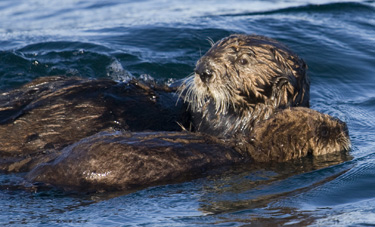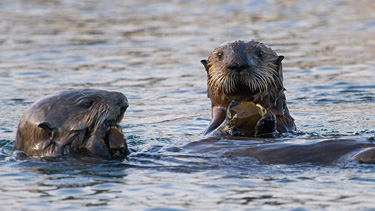Parents often complain that child-rearing is exhausting, but consider the poor sea otter mom. By the time a sea otter pup is weaned, its mother may be so depleted physiologically that she is unable to survive the stress of a minor wound or infection. Sea otter researchers have a term for it—"end-lactation syndrome" —and believe it accounts for high mortality rates among female sea otters in some areas.
To understand why this happens, UC Santa Cruz biologist Nicole Thometz set out to quantify the energy demands of a growing sea otter pup. Her results, published June 11 in the Journal of Experimental Biology, reveal just how much it costs a sea otter mom to raise her pup.
High energy requirements
Even without a pup, adult sea otters have remarkably high energy requirements, eating about a quarter of their body weight in seafood every day. As the smallest marine mammals, living in cold coastal waters with thick fur but no insulating layer of blubber, sea otters need to maintain a high metabolic rate to stay warm. They may spend 20 to 50 percent of the day foraging for food. For an adult female, a pup adds new demands to an energy budget that is already challenging.
Thometz and her colleagues found that the daily energy demands of a female sea otter jump by 17 percent in the first few weeks after the birth of a pup and grow steadily as the pup gets larger. Eventually, the mother's daily energy demands are 96 percent higher, nearly twice what they are when she doesn't have a pup. In other words, she has to find almost twice as much prey every day to keep herself and her pup fed.
"These fundamentally high energy demands are likely the underlying reason why we see so much mortality among prime age females in the middle of their range, where the density of the sea otter population is highest and resources are limited," said Thometz, who conducted the study as part of her Ph.D. thesis research at UCSC. She is currently a postdoctoral researcher in the mammalian physiology lab of coauthor Terrie Williams, professor of ecology and evolutionary biology.
The UCSC researchers teamed up with the Monterey Bay Aquarium to study the energetics of growing sea otter pups. The aquarium's sea otter program takes in pups found stranded in the wild and uses otters at the aquarium as surrogate mothers to raise the pups until they can be returned to the wild. Thometz worked with seven sea otter pups, measuring their oxygen consumption to determine metabolic rates at different activity levels throughout their development.
Observations in the wild
The researchers also observed sea otter pups in the wild to see how much time they spent each day resting, grooming, foraging, and so on. Combining these "activity budgets" in the wild with the metabolic rates measured in pups at the aquarium enabled Thometz to calculate average daily energy demands for pups at five developmental stages. The daily energy demands of adult female sea otters without pups were calculated using previous research conducted by Williams and coauthor Michelle Staedler of the Monterey Bay Aquarium.
It takes about six months for a female sea otter to raise a pup until it's weaned and starting to feed itself. During this time, the pup is highly dependent on its mother for food. "The majority of the pup's calories come from its mother, so we tracked the combined energy demands of mom and pup over time. Given that sea otters have such high baseline energy demands, what these females are doing to raise a pup is really extraordinary," Thometz said.
These findings explain why female sea otters are so often found in poor condition--weak and skinny--at the end of the lactation period. It also helps explain why sea otter mothers may abandon a pup before it is fully grown. Thometz explained that female sea otters give birth to a pup every year, regardless of their condition. They decide whether to keep or abandon their pup depending on their physiological condition and environmental factors such as the availability of prey. Abandoning a pup may give them a better chance to successfully rear a pup the following year.
These phenomena--females in poor condition and abandoned pups--are much more common in the center of the sea otter's range along California's central coast than they are at the northern and southern ends of the range. Thometz said there are fewer otters and less competition at the ends of the range, making it easier for a female to find enough food to meet the energy demands of raising a pup. In the center of the range around Monterey and Big Sur, the sea otter population may have reached the "carrying capacity" of the environment, meaning there's just not enough food to support further growth of the population in that area.
"These females have to accomplish a huge energetic task every year. In the center of the range, they appear to be up against their physiological limits," Thometz said.
In addition to Thometz and Williams, the coauthors of the paper include Tim Tinker, a U.S. Geological Survey biologist and adjunct professor of ecology and evolutionary biology at UCSC; and Michelle Staedler and Karl Mayer of the Monterey Bay Aquarium. This research was funded by the USGS Wesern Ecological Research Center, the Office of Naval Research, the Otter Cove Foundation, and the Meyers Oceanographic and Marine Trust.




